 It has been a good 3 months since the death of former North Korean strongman Kim Jong-Il; its almost a quarter of a year since the death of the ‘dear leader’, a good enough time frame to assess whether the North has made any ‘progress’ in becoming a country that is ‘diplomatically-acceptable’ to the West.
It has been a good 3 months since the death of former North Korean strongman Kim Jong-Il; its almost a quarter of a year since the death of the ‘dear leader’, a good enough time frame to assess whether the North has made any ‘progress’ in becoming a country that is ‘diplomatically-acceptable’ to the West.
Despite mixed-reactions on his death and the installment of its new premier Kim Jong-un, 2012 commenced with a new US defense stance, where Defense Secretary Leon Panetta announced, with utter confidence, that the US military will increase its “institutional weight and focus on enhanced presence, power projection, and deterrence in Asia-Pacific.” He also added that, despite settling for obvious (economic) tradeoffs, the US “will have the capability to confront and defeat more than one adversary at a time.” Furthermore, the US will re-balance its “global posture and presence, emphasizing the Pacific and Middle East- these are the areas where we see the greatest challenges for the future.”
Together with its North-Asian partner South Korea, the US was quick to follow up on this posture by staging a huge military exercise off the Peninsula, which began on March 1. It involved some 200,000 regular South Korean troops and reservists and about 12,800 US troops. The two-stage ‘defensive in nature’ military exercise naturally is seen by North Korea as a threat to its regime, and must be tackled with extreme caution. The North Korean newspaper Rodong Sinmun declared ““If a war breaks out on the peninsula, only a nuclear catastrophe will be triggered.”
Containing China
The US leadership is also firm in its Southeast Asian posture. In their new report “Sustaining US Global Leadership: Priorities for 21st Century Defense”, it was confirmed that Washington will be building better military alliances and reestablish closer military ties with the Philippines, Indonesia, Vietnam, and of course, Taiwan. In January, the US has completed a new joint military exercise with the Philippine military aimed at countering alleged Chinese intervention in disputed waters. And that does not end there, during a visit to the Philippines by no less than Secretary of State Hilary Clinton, both nations signed “The Manila Declaration” which meant closer cooperation “to enhance the defense, interdiction, and apprehension capabilities of the Armed Forces of the Philippines.” It also indicated that the US “also reaffirm(s) the treaty as the foundation of…(their) relationship for the next 60 years and beyond.”
Meanwhile, in a visit to Canberra late last year, President Barrack Obama disclosed that it will focus America’s might in Australia and Asia, where he announced “as we plan and budget for the future, we will allocate the resources necessary to maintain our strong military presence in this region.” Moreover, both nations signed an agreement to increase US military presence in Northern Australia by upgrading the troops there from 250 to 2,500 personnel.
Undeniably, Bush’s “war on terrorism” will now be replaced by patrolling the greater region of the Asia-Pacific. Does the Pacific miss being an arena of an Arms Race? Since the collapse of the Soviet Union, Washington has enjoyed being the sole unchallenged power in the region. For China, though, the breakneck development of its economy necessitates the protection of its interests, where the protection of energy lanes becomes more vital than ever. Indeed, in this global game of energy security, the US is holding back not only China’s access to energy, but also its capability to protect those interests.
Still, it seems Washington is not satisfied threatening China from the East; in an unprecedented stance, Mrs. Clinton also visited Burma, a long-time Chinese ally. In an effort to distance Burma from China, Clinton said that countries should be ‘smart shoppers’, which meant that they should veer away from countries that are more interested in ‘extracting your resources than in building your capacity.’ Evidently, this statement is for its giant neighbor, where Burma is heavily reliant on. Beijing has invested heavily in this tiny nation for some resources in return for aid as well as access to the Indian Ocean, having the objective of becoming less reliant on the Malacca Strait, a region heavily policed by the West. Furthermore, Washington has established the Lower Mekong Initiative that aimed to relax Chinese influence in the member countries of Cambodia, Laos, Thailand (which recently received F-16 fighter jets) and Vietnam.
documents:
US Department of Defense: Sustaining US Global Leadership 2012
US Department of State: The Manila Declaration
further read:
